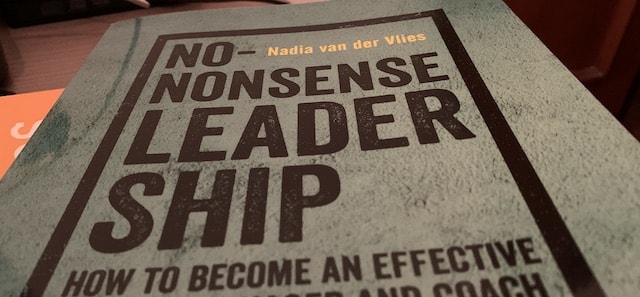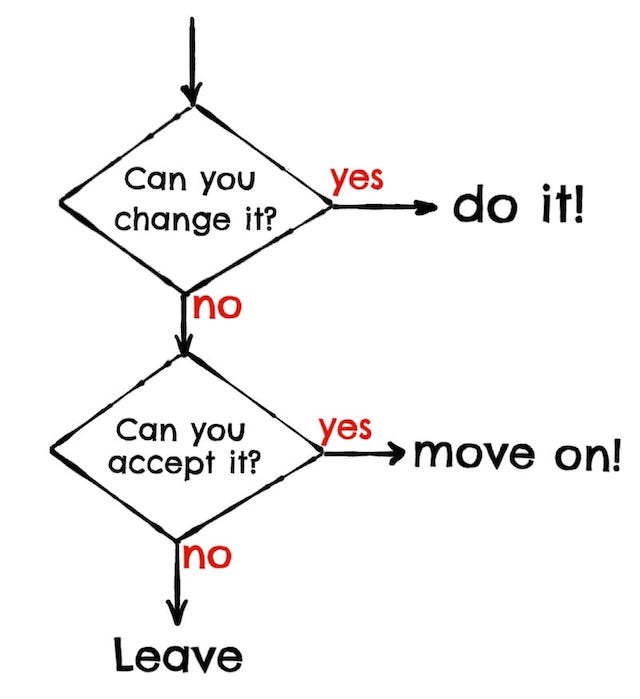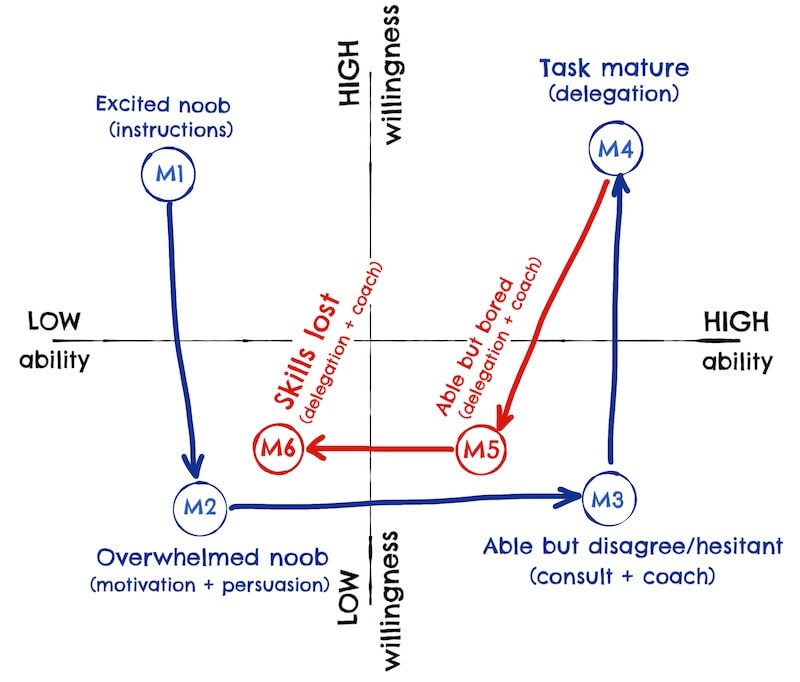Book notes: No-Nonsense Leadership
Book notes on "No-Nonsense Leadership"

These are my notes on Nadia van der Vlies’s No-nonsense Leadership.
It contains quite practical advice, but it is not software/engineering specific.
Keeps the trend on other leadership books: Empower people by letting them find their own solutions.
Key Insights
- Mature leadership:
- High empathy, High honesty.
- Treat others as equals.
- Everybody can self-manage.
- Empower people to come up with solutions.
- Bidirectional trust.
- New behaviours are acquired by doing, doing and doing.
- To keep control, take ownership:

- Keep sharing the mission, vision and strategy.
- You are no longer one of your (ex-)co-workers.
- Performance reviews:
- Negative reviews should never come as a surprise.
- Make notes through the year.
- Would I hire this employee if they were applying for their current position?
- Give compliments regularly:
- Stimulate culture where people speak positively about others.
- Be specific.
- If you want your employees to feel safe, you have to show some vulnerability.
- Coaching:
- Coaching means biting your tongue a lot.
- A success is an attempt to change behaviour, even if the attempt failed.
- Coachee is responsible for his personal development.
- To reflect is to learn.
- If you work hard, other wont have to.
- Respectful confrontation.
- Delivering bad news.
TOC
- 1 - No-Nonsense Leadership
- 2 - Leadership Skills
- 3 - Leader, Manager, Coach
- 4 - Leader
- 5 - Manager
- 6 - Coach
- 7 - Reflexes
- 8 - Tricky Situations
- 9 - The truism of no-nonsense leadership
Chapter 1 - No-Nonsense Leadership
- Mature model based on Transactional Analysis.
- Mature:
- Treat others as equals.
- Everybody is a responsible human being.
- Everybody can self-manage.
- Coaching leadership style.
- Empower people to come up with solutions.
- Honest.
- Conscious and considerate choice.
- Bidirectional trust.
- You need:
- Empathy.
- Honesty.
- Pitfalls:
- Mother:
- High empathy. Low Honesty.
- Always eager to help.
- Effects:
- Takes away responsibility, hence opportunity to grow.
- Leader become overworked.
- Macho:
- Low empathy. High Honesty.
- I know better attitude. Judgemental.
- Effects:
- Obedient or rebel employees.
- Takes away responsibility, hence opportunity to grow.
- Mole:
- Low empathy. Low Honesty.
- Avoids confronting issues.
- Effects:
- Nothing is improved.
- Mother:
- Pitfalls are not pitfalls if you consciously chose them and don’t use them often.
Chapter 2 - Leadership Skills
- Situational leadership:
- Use a different kind of leadership depending on employee task maturity.
- Task Maturity:
- Willingness to do the task.
- Ability to perform it.
- Levels M1 to M6:
- M1: Loads of detailed instructions.
- M2: Still lots of instructions, but also explain the why.
- M3: Focus on person, not task.
- How to asses task maturity? Ask employee.

- Taking ownership:
- Keep your values in mind.
- When things do not go as expected, to keep control you have to:

- Conversations:
- Keep three perspectives: yours, the others, that of an objective observer.
- Active listening:
- Listen.
- Recap:
- Use your own words unless is a delicate matter.
- Content and feelings.
- Keep asking questions.
- Tolerate silences.
- Stay in control:
- Commit: set the goal.
- Monitor: check if the talking is relevant.
- Off topic: draw attention and ask if it is relevant.
- Difficult interaction: draw attention and ask why.
- Two tracks: commit again.
Chapter 3 - Leader, Manager, Coach
- You are no longer one of your (ex-)co-workers.
- Leader before Manager or Coach.
Chapter 4 - Leader
- Enthusiastic, authentic.
- Keep sharing the mission, vision and strategy.
- Know and learn company values.
- Motivate and inspire:
- Share conclusions and reasoning.
- Show appreciation.
- Repeat yourself.
- Connect.
Chapter 5 - Manager
- Translates Vision to Goals:
- Employee translates goals to solutions.
- Let employees have a say on their goals to create greater commitment.
- Monitor and review results and behaviours:
- Respectful confrontation:
- Step 0: reflect if it is you or the employee.
- Step 1: Expose facts and only facts.
- Use first person.
- No judgement.
- Be very specific.
- Step 2: The effect it causes.
- I think + I feel + I act.
- Step 3: Ask “Is this something you recognize?”
- Step 4: Explain your request/desire.
- This is the kick-off for a conversation.
- Dealing with responses:
- Reflect on feeling.
- Explain.
- Guess underlying need.
- Express your need.
- Make your request/proposal.
- Respectful confrontation:
- Asses and adjust:
- Performance review:
- Your employee is never your equal.
- Demotivating for others if poor performing coworkers get same pay raises.
- Make notes through the year.
- Would I hire this employee if they were applying for their current position?
- SMART goals.
- Start with the good things.
- Negative reviews should never come as a surprise.
- Ask for feedback on the assessment.
- Give compliments regularly:
- Stimulate culture where people speak positively about others.
- Honest.
- Specific.
- Do not delay it.
- Delivering bad news:
- Deliver the blow:
- Go straight to the bad news.
- Give one or two reasons.
- Manage the reaction:
- Be understanding. Do not justify yourself.
- Give space. Do not fill silences.
- Solution, explanation, follow up appointment:
- Wait for the employee to be ready. When she starts asking “why” or “what now”
- Reiterate reasons.
- Maybe follow up with another meeting.
- Deliver the blow:
- Performance review:
Chapter 6 - Coach
- Coaching as a manager is more difficult as you already expect something from your employee.
- Do not give tips or advice.
- Coachee comes with their own problems and solutions.
- Coachee is responsible for his personal development.
- Accept what it is, without judging. Emphatic.
- Pitfalls:
- Comparing and going one worse.
- Educating and giving advice.
- Playing down the problem.
- Interrogating.
- Psychoanalyzing.
- Join in and making it worse.
- Walk ins with no clear question or need:
- Respectful interrogation.
- Emotion reflection.
- What do you want from me? What is your question?
- Commit: on condition, now, later, never.
- Coaching without a coaching goal is pointless.
- Marteen Kouwenhoven coaching matrix 4 doors:
- Thought door: get the facts.
- Emotions door: why is this a problem to be solved?
- Needs door:
- Positive opposite of emotions door.
- Cannot be about others changing.
- Actions door:
- Coachee should find her own solutions.
- Coaching means biting your tongue a lot.
- Celebrate success:
- Start coaching session by talking about successes.
- A success is an attempt to change behaviour, even if the attempt failed.
- Growth mindset:
- Learning about fixed vs growth can get you out of the fixed mindset.
- If you want your employees to feel safe, you have to show some vulnerability.
Chapter 7 - Reflexes
- Beliefs that get on your way to do what you have to do.
- “Survival” strategies.
Chapter 8 - Tricky Situations
- Passive employee, defiant employee, moaning employee, …
- Respectful confrontation
- Top performing employee:
- Sincere and explicit compliments.
- Not everyone wants to develop further.
- Check regularly so they dont get bored.
- Quarreling employees:
- Employee should state exactly what she expects from you. This makes her responsible for the solution.
- Employees should settle it themselves.
- Make sure employees responsibilities are well defined.
Bonus 1 - The truism of no-nonsense leadership
- To reflect is to learn.
- The answer to most questions is “lets talk about it”
- If you have something to say, say it. If you have something to ask, ask it.
- If you work hard, other wont have to.
- New behaviours are acquired by doing, doing and doing.